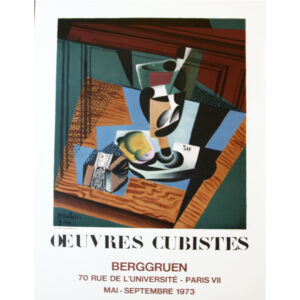Grey, Juan
Juan Gris (1887-1927) was a Spanish Cubist painter, famous for his geometric compositions and bold use of color. Close to Picasso and Braque, he brought a unique clarity and intellectual rigor to Cubism. Despite his short career, his work left its mark on the history of modern art.
Read more
Here is the only result
Biography of Juan Gris
Juan Gris (1887-1927), whose real name was José Victoriano González-Pérez, was a Spanish painter and sculptor, recognized as one of the masters of Cubism. Born in Madrid on March 23, 1887, Gris was the thirteenth child of a modest family. He showed an early talent for drawing, which led him to study at the Madrid School of Arts and Crafts. There, he initially trained in engineering, but soon turned his attention to art, becoming an illustrator for satirical magazines while developing his own style.
In 1906, at the age of 19, Gris left Madrid for Paris, attracted by the artistic effervescence of the French capital. In Paris, he settled in Montmartre, where he came into contact with many avant-garde artists, including Pablo Picasso and Georges Braque, who were to have a decisive influence on his work. Although Gris began his career as an illustrator, he soon turned to painting, adopting the principles of the emerging cubist movement.
Gris became a leading exponent of Analytical Cubism, a style characterized by the fragmentation of objects into geometric shapes and the representation of multiple viewpoints on a single flat surface. However, unlike Picasso and Braque, whose cubism was often dark and monochrome, Gris introduced a bold, harmonious use of color and a rigorous sense of composition. His painting is distinguished by a clarity and precision that lend his works an architectonic quality.
His early cubist works, such as Le Portrait de Picasso (1912) and La Guitare sur une table (1915), demonstrate his mastery of cubist technique while asserting his own style. Gris also explored collage and the integration of various materials into his paintings, enriching the cubist vocabulary.
From 1912, Gris began to exhibit his work regularly, notably at the Salon des Indépendants and the Salon d'Automne in Paris. He made friends with gallery owners Daniel-Henry Kahnweiler and Léonce Rosenberg, who became his main art dealers. These exhibitions and connections helped Gris gain recognition in European art circles.
In the 1920s, Gris reached the full maturity of his art. He gradually moved away from analytical Cubism to adopt a more synthetic style, with simplified forms and more decorative compositions. Works from this period, such as Nature morte avec nappe à carreaux (1915) and La Fenêtre ouverte (1921), reveal a subtle balance between abstraction and figuration, where each element is carefully arranged to create visual harmony.
In addition to his painting, Gris was also interested in art theory. He wrote several essays in which he defended a rational, intellectual approach to painting, arguing that art should be the product of methodical reflection rather than mere emotional expression. This theoretical thinking influenced not only his own work, but also that of many other artists.
Despite his artistic success, Gris suffered from serious health problems. From 1925 onwards, he suffered from chronic bronchitis and asthma attacks, which considerably weakened his physical condition. Juan Gris died prematurely on May 11, 1927, at the age of 40, in Boulogne-Billancourt, leaving behind a relatively small but highly influential body of work.
After his death, Juan Gris' work continues to be recognized as a major contribution to Cubism and modern art. His paintings, characterized by their geometric precision, colorful palette and thoughtful composition, are preserved in the world's greatest museums, such as the Museum of Modern Art in New York (MoMA), the Centre Pompidou in Paris, and the Museo Reina Sofía in Madrid.
Today, Juan Gris is celebrated not only as an innovator of Cubism, but also as an artist who fused intellectual rigor and artistic sensibility in a unique body of work that continues to inspire future generations.

